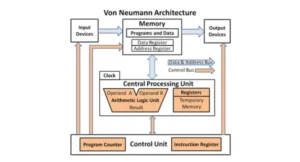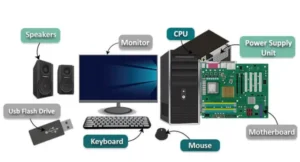A/B testing in email marketing is an effective email testing approach. It enables you to determine what works best in your email campaigns. You can conduct A/B split testing by sending two email versions to different recipients. This is known as split testing or an email A/B test. Then you see which one performs better. Consider results such as openings, clicks, and sales. Tracking essential email marketing KPIs like open rates, click-through rates, and conversion metrics helps you measure the true impact of your A/B testing efforts. A/B testing in email marketing helps to enhance emails incrementally. It uses test variants and variables to improve outcomes. This type of exploratory testing reveals what your audience prefers. Testing campaigns like this ensures that your emails are noticed and not filtered as spam. It’s an excellent strategy to build success. A well-defined email marketing strategy that incorporates regular A/B testing ensures your campaigns align with business objectives and audience preferences.
A/B testing can help you get more individuals to open and click your emails. It also reduces unsubscribe rates and spam reports. This improves and maximizes the effectiveness of your emails.
Improve Open Rates and Click-Throughs
Getting someone to open your email is the first important step. A/B testing improves email open rates by experimenting with different subject lines, sender names, and preheaders. You can also investigate how these influence click-through rates (CTR). When someone opens your email, you want them to click. Try different button colors, link styles, and CTA phrases. This improves clicks, click performance, and user engagement. Better engagement rates indicate that your emails are functioning. Even minor tweaks can significantly improve email engagement. It’s all about figuring out what people like and exploiting that to generate more openings and clicks.
Increase Conversions and Sales
Clicks are excellent, but persuading people to take action is even better. That’s known as a conversion. A/B testing improves conversion rates by testing offers, headlines, and CTA buttons. You can test conversion optimization by including a free trial in one email and a discount in another. See which one works best. These tests result in greater campaign performance and enhancements. It also improves your marketing conversion rates and overall marketing performance. Campaign statistics reveal which email wins. When you test properly, your emails result in more purchases, signups, and better campaign results.
Reduce Unsubscribes and Spam Reports
People can become annoyed when they receive too many emails. They may unsubscribe or flag your email as spam. This negatively impacts your sender reputation and mailbox placement. Understanding and addressing email deliverability issues is crucial for ensuring your A/B test results accurately reflect subscriber engagement rather than inbox placement problems. A/B testing helps you avoid this. You can test email frequency and sender customisation. Try sending emails less frequently or with a friendlier sender name. This reduces spam complaints and keeps your audience satisfied. When consumers feel appreciated, they continue to subscribe. Better email deliverability means that more of your emails end up in inboxes. Monitoring your email delivery rate alongside A/B test metrics provides a complete picture of campaign performance and helps identify potential delivery obstacles. Protecting your sender identity and keeping your list clean are essential. This ensures that your emails are both welcome and trusted.
What to Test in A/B Testing for Email Marketing
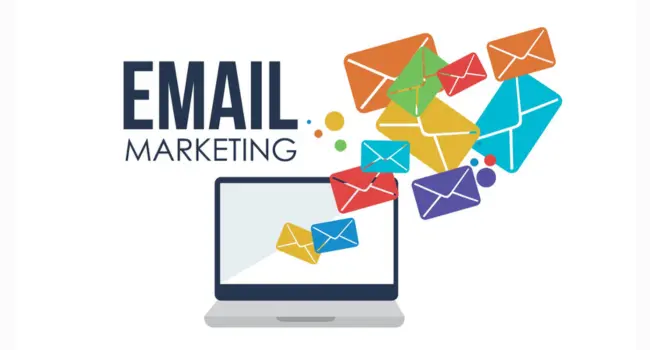
Test critical components such as subject lines, sender names, email content, and send times. Small tweaks to your email marketing campaigns can increase open rates, clicks, and engagement.
Subject Line Testing
The subject line is the first thing they notice. Subject line testing allows you to determine the best strategy to get attention. Compare short vs. long-form subject lines. Use newsletter subject lines that are targeted to your readership. You may test tone, personalization, and even emojis. An emotional topic line can increase openings. Boring ones may be ignored. Subject line optimization improves open rates. Testing allows you to learn what works best for your audience. Some readers prefer a serious tone. Others prefer something amusing. By testing, you may send emails that people are eager to read.
Length, Tone, Personalization, Emojis, Urgency
Different topic line styles can produce varying effects. Compare short topic lines to long ones. Try using emotive or positive language to discover which works best. Personalize your message by including the recipient’s name. This can give the email a more personal vibe. Test the message tone — pleasant or formal — to see which generates more opens. Emojis can help make your subject line stand out. But not everyone likes them. You can also build urgency by utilizing phrases like “Act now” or “Last chance.” The fear of missing out (FOMO) drives people to open emails immediately away.
Sender Name and Preheader Text
The sender name informs recipients who the email is from. Try comparing a firm name to a friendly sender name. Some individuals trust senders who use brand names. Others want an individual sender name. Testing sender name customisation can boost trust and open rates. The preheader, often known as preview text, is the short phrase that appears beside the subject line. It provides extra information about the email. Preheader testing and tuning can assist enhance results. A nice preview text encourages people to open your email. Together, the sender name and preheader contribute to increased trust and email performance.
Email Content and Layout
When people open an email, they see its content. Content testing allows you to play with different layouts, message lengths, and designs. Depending on who you are targeting, you can use either short or went copy. Email writing that has tale content or emotive views often does better. Try email pictures or stick to text. Content layout and message clarity are other significant factors. Some people prefer plain, plain messages. Others love rich design. You may also test optimization for phones to be sure that it works well on all devices. Testing multiple content options improves content significance and user experience.
Copy Length, Style, Personalization, Storytelling
Compare short and long-form copy. Some readers like immediate information. Others enjoy complete stories. Email style is also crucial. You can write in either official or casual style. Personalization makes your email unique. Try adding the individual’s name or location. Storytelling material allows people to connect with your message. Use positive words to ensure that your message is nice and clear. Good content keeps your viewers engaged. Continue testing to determine what works best for your readers. Personalized emails with a pleasant tone and a brief message may receive more clicks and responses.
Images vs. No Images, HTML vs. Plain Text
Images make emails look better. However, some gadgets don’t display them well. Try image testing to determine whether your readers prefer emails with or without visuals. Compare picture vs. no image layouts. HTML emails have a designed appearance with visuals. Plain-text emails are simple. Some individuals trust basic emails more. Others prefer vibrant designs. You may also see how your emails appear on mobile devices. Testing email format ensures that everyone can read your message. The idea is to determine whether your audience prefers extravagant or plain.
Call-to-Action (CTA) Testing
The call-to-action (CTA) indicates what readers should do next. It might read “Buy Now,” “Read More,” or “Sign Up.” Testing your CTA improves click rates. Compare call-to-action buttons or button vs. text links. CTA testing allows you to employ effective CTA terms and action-oriented language. The right CTA encourages users to click. You can also try other button sizes, shapes, and colors. Focusing on clear and direct actions improves CTA testing results. A strong CTA is one of the most effective strategies to encourage people to take the next step.
Button Text, Color, Placement, Urgency
Test alternate button text, such as “Join Now” or “Start Free.” Try red, blue, or green buttons; color can influence how people react. The button color test helps you determine which one receives the most clicks. Button placement is also important. Place the button near the top or in the center. When the CTA is clear, certain people are more likely to click. Use urgency to get others to respond quickly. Words like “Limited Time” and “Ends Soon” work nicely. This sense of urgency causes fear of missing out (FOMO), which can lead to an increase in clicks.
Send Time and Frequency
Send timing is important in email marketing. Test when your readers like to receive emails. Try sending emails on both weekdays and weekends. Some folks read emails on Monday mornings. Others check at night. Time-of-day testing reveals what works best. Also, try sending emails once a week or more frequently. Too many emails may result in unsubscribes. However, too few may cause others to forget you. Time zone optimization is also significant. Send emails when folks in each time zone are online. A clever sending schedule boosts open and click rates.
Day of Week, Time of Day, Time Zones
Send emails on different days – weekdays versus weekends. Monday may work for some. Saturday may work for others. Consider sending in the morning, midday, or evening. This is referred to as time of day testing. Some people check their emails in the morning. Others check email at night. Always examine your audience’s habits. Don’t forget about time zones. Someone in New York and another in London check their emails at different times. Time zone optimization guarantees that your email is delivered at the proper time. Testing these options enables you to discover the optimal send time.
Design and Visual Hierarchy
The way people react to emails is heavily influenced by their design. Good design directs the reader’s eye. Evaluate the layout, colors, and visual elements. The design should be clear and easy to read. Button visibility is also important. Your call to action should stick out. Try different headline sizes and layouts. Strong headlines with huge letters attract attention. Layout testing allows visitors to see your message clearly. Use hues that complement your brand while still standing out. Visual hierarchy refers to putting the most significant items first. Good email visuals allow readers to understand your message more quickly and easily.
Headline Size, Layout, Button Visibility, Colors
Try several headline sizes, such as huge and bold or small and clean. Try layouts with stacked content or columns. See which one works best. It is also important to consider the visibility of buttons. Make your CTA button stand out. Use bright, contrasting hues. Try different colors, such as red, green, and blue. Good layout and color selections will help your reader. If the title is clear and the buttons are easy to find, more people will click. Clean and straightforward designs typically function best. Always ask your audience what they like. Continue experimenting for better results.
Personalization and Dynamic Content
Personalization makes your emails feel more special. You can enter a subscriber’s name, previous purchases, or location. This is known to be fluid content. Testing adaptation boosts subscriber engagement. Consider adding specific material, such as product suggestions. Also, use audience segmentation to send emails based on behavior. When users get emails that match to their interests, they are likely to respond. Customized material increases trust and makes your emails stand out. A/B testing allows you to see which kind of variation looks the best to your audience. It also improves the total email recipient reaction.
Offers, Product Recommendations, Milestones
Test out a few promotional offers, such as savings or free shipping. Try making suggestions for goods based on what others have bought. Celebrate significant days such as birthdays and sign-up dates. These simple touches can have an immense effect. Personal offers appear to be more respectful. Milestones allow people to feel noticed. You can also test how people react to various types of ads. A special birthday offer may perform better than a generic sale. Particular emails that include these parts increase subscriber interest and loyalty. Dynamic content keeps emails interesting, friendly, and timely.
Incentive Types
Incentives motivate people to take action. You can test several types, such as discounts, free trials, and gifts. Urgent offers such as “Ends Today” can get speedier reactions. Some folks adore bargains. Others prefer free things. A/B testing lets you determine what works best. Consider sending a coupon in one email and a free trial in another. See which one generates more clicks or sign-ups. You may also use urgency offers to instill fear of missing out (FOMO). The correct incentive can increase outcomes and make your efforts more effective.
Tips for Running A/B Tests in Email Marketing
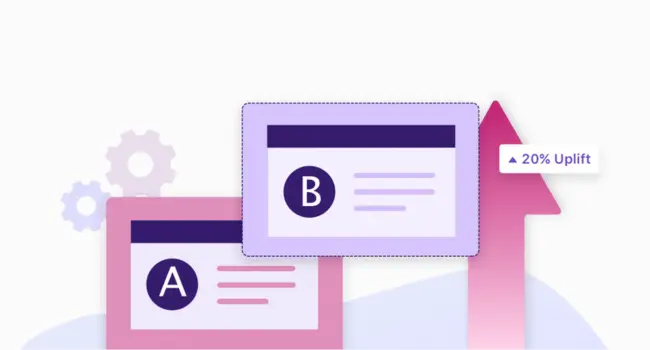
Follow specific steps, such as formulating a hypothesis and testing a single factor at a time. To achieve the best results in your email campaigns, use smart test prioritization and be patient.
Start With a Hypothesis
Every test need a purpose. Begin by formulating a test hypothesis. A hypothesis is a suggestion or assumption about what may work better. For example, your marketing hypothesis may be: “Using a person’s name in the subject line will increase opens.” This is also known as an experimental hypothesis. Testing hypotheses can help you make better decisions. It explains what you should look for in the results. When your hypothesis is clear, your test will be more focused. It also facilitates learning from the test. A strong hypothesis produces greater results in email marketing.
Test Only One Thing at a Time
Always test one item at a time. This is known as a single variable test. If you modify more than one thing, you’ll have no idea what made the difference. For example, merely modify the subject line or CTA button color. This is known as testing one variable. It helps you understand what worked. When you adjust both at once, your results become jumbled. Simple and targeted testing produce superior results. Only test one thing per email. This way, you’ll know which changes contributed to the success of your email campaign.
Prioritize High-Impact Tests
Not every test produces the same findings. That is why test prioritization is critical. Begin with the modifications that make the most effect. These are known as high-impact variables. Subject lines, CTA buttons, and sender names are common high-impact testing areas. Don’t waste time on minor tasks that won’t assist much. The test impact should be significant enough to matter. Choose the most critical element of the email and test it first. This saves time and provides better outcomes. Concentrate on testing that will help your email’s success swiftly and clearly.
Don’t Change Tests Midway
Allow a test to run till completion. Don’t make changes to the test halfway through. Early changes might wreak havoc on the data. You must allow the test to complete its full course. Even if the results appear to be evident right away, wait. The complete test provides actual answers. Stopping or modifying it midway can produce incorrect results. Be patient and let the test to complete. This increases your trust in the outcome. A good test requires entire time to function. So, always finish what you started and avoid making changes throughout the test.
Give Tests Enough Time
Good results require time. Patience is required when doing an analysis. Don’t expect to get answers in one day. Some email tests require many days. Others might need weeks. It depends on the size of your email list and the number of individuals that open the email. Rushing can provide incorrect results. Give your A/B test adequate time to collect actual data. Watch how open rates, click rates, and other metrics gradually increase. Waiting allows you to realize what actually works. So, be patient and let the test to run for an appropriate amount of time.
Use a Big Enough Sample Size
To acquire genuine responses, you need a large enough email sample size. If you test with too few people, the results may not be accurate. Before you begin, make sure your minimum sample size is met. A small group might provide unpredictable results. However, a large sample allows you to see actual trends. Larger tests increase your faith in your decisions. It’s like asking 100 people rather than just five. More people provide better responses. So, always utilize the appropriate sample size to ensure that your email test results are robust and clear.
Focus on Emails You Send Most Often
Perform A/B tests on recurrent campaigns. These are emails that you send repeatedly, such as weekly newsletters or product updates. When you strengthen these, it benefits your entire campaign. Testing emails you send on a regular basis provides more long-term benefits. You can use the same test findings in future emails. These emails reach a larger number of people more frequently. So adjustments here are more important. Concentrate your testing on those first. That manner, each change you make yields a higher return over time. It’s the smartest method to improve your email performance.
Tools to Use for A/B Testing in Email Marketing

Use email marketing sites like as Mailchimp and Campaign Monitor to to simply conduct A/B tests. Advanced email automation tools can streamline your A/B testing process by automatically sending variants and collecting performance data without manual intervention. These tools track data and help you optimize your email testing for greater success in marketing.
CoSchedule Headline Analyzer
CoSchedule Headline Analyzer is ideal for subject lines. It analyzes your headlines for length, clarity, and emotion. This enables you to create better subject lines for email marketing. You can test the strength of your message before sending it. The tool evaluates your subject line and identifies areas for improvement. It also tells you whether the line is too long or too short. Using the CoSchedule Headline Analyzer makes your emails more interesting. Strong subject lines can boost open rates. This straightforward tool makes subject line testing simple, quick, and effective for improved email performance.
Mailchimp A/B Testing Tools
Mailchimp is a prominent email marketing platform. It includes built-in A/B testing tools. You can experiment with subject lines, send times, email designs, and more. Mailchimp, an email service provider (ESP), assists marketers in creating more effective email campaigns. It’s simple to use, even if you’re new to email marketing tools. You can test different versions of your email to determine which one performs better. The program also provides information on open rates, clicks, and other metrics. Mailchimp allows you to do effective A/B tests and gradually improve the efficacy of your campaigns.
Campaign Monitor Analytics
Campaign Monitor provides robust campaign analytics and A/B testing skills. It allows you to better analyze how your email marketing function. You can test the subject lines, content, and layout. Their email analytics suite displays data such as open rates, click-throughs, and more. This tool improves your emails by using real numbers. Campaign Monitor is ideal to find out which emails perform better. It allows for wiser A/B testing with clear reports and simple features. If you want to make better email decisions, Campaign Monitor is a useful tool for assessing and improving email success.
Sender Score for Reputation Tracking
Sender Score allows you to verify your sender reputation. It reveals whether your emails are trusted or flagged as spam. A low score indicates that your emails may not reach inboxes. Tracking your Sender Score can help enhance email delivery. It notifies you if there is a problem with your email sending. A good sender reputation makes A/B testing more effective. When your emails arrive in inboxes, more people can open and click. This improves the accuracy of your test results. Sender Score provides a clear picture of how email providers see your messages.
Omnisend for No-Code A/B Testing
Omnisend is a marketing automation solution. It enables simple A/B testing with no coding needed. This means that anyone can use it. You may use automated A/B testing within your email workflows. Without putting in extra effort, play with the second subject lines, content, and sending times. Omnisend runs tests for you. Its automation workflows save time and allow you to learn quickly. The tool also tracks metrics such as openings, clicks, and conversions. Omnisend is ideal for busy marketers seeking quick and easy testing. It’s simple to improve your email speed without having to code any.
How to Read and Use A/B Testing Results
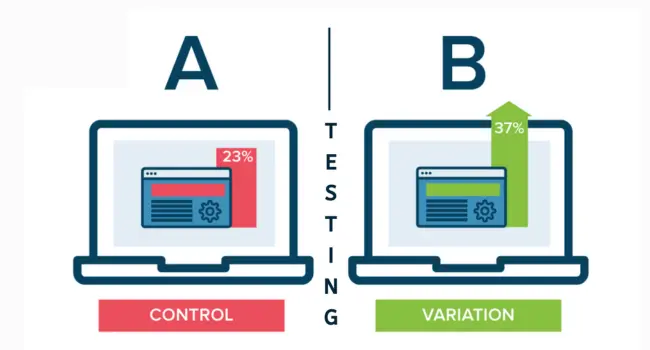
Learn how to identify the best version by looking at key metrics such as open rates, CTR, and sales. Use categories of recipients to comprehend more results and improve future marketing via emails.
Identify the Winning Version
To understand A/B testing, first determine which email performed best. This is the winning version. Use either manual or automatic winning criteria. You can choose according to open rates, clicks, or conversions. Always use unambiguous winning criteria. The best-performing email demonstrates what your audience enjoys the most. Keep the test arrangement fair. A positive outcome helps you understand what works. Choosing the winning version will help your future campaign improve. Don’t guess; let the numbers tell you. Always test carefully, and keep records of which version wins. This improves email success over time.
Use Key Metrics: Open Rate, CTR, Conversion Rate
Always review your email stats following a test. Open rates, click-through rate (CTR), and conversion rate are all important metrics. These demonstrate how well your email performed. High opens indicate that your subject line worked. High CTR indicates that people clicked on your links. Conversions indicate whether users took action. These metrics help make sound decisions. Use them to evaluate email performance. Track each step of the email journey. Understanding the numbers allows you to achieve greater results. Every exam becomes easy to grasp once you know what to look for. These easy measures will assist improve future email campaigns.
Analyze Results by Segment
Don’t just look at the totals. Break the test down into sections using campaign segmentation. Examine how different audience segments respond. This is referred to as email segmentation or segmentation targeting. Emojis, for example, may be popular in subject lines among younger people. This may not be true for older users. When you analyze A/B test results by group, you’ll see patterns. This enables you to examine campaigns more intelligently. Use the results to see what each group prefers. It provides further insight. Knowing your target audience helps you achieve better results. Always examine results objectively for more targeted success.
Apply Learnings to Future Campaigns
After the test, apply what you’ve learnt. These are called test learnings. Don’t forget them. Write them down and include them in your next email. This helps with marketing optimization. Being data-driven refers to learning from past data. Use data-driven insights to make smarter decisions. This makes your emails smarter over time. Each test teaches something. Minor adjustments add up. When you build your campaign enhancements on facts, you will see faster results. Always take notes and implement what you learn. This is how to improve your email outcomes over time.
Advanced A/B Testing Tips for Email Marketing
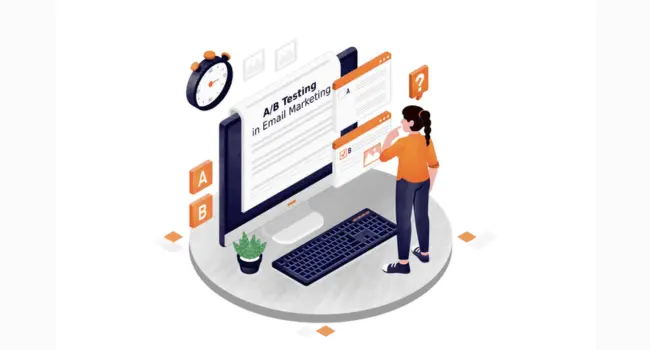
Use smart artificial intelligence (AI) and automation to make testing faster and easier. Combine A/B testing and segmentation of your audience to create emails that your readers will enjoy and engage with more.
Use AI for Smarter A/B Testing in Email Campaigns
Artificial intelligence can improve A/B testing. AI-powered testing use intelligent techniques such as predictive analytics and natural language processing to figure out what performs best. These tools help you test emails more quickly and effectively. Generative AI may offer new ideas for subject lines and content. Predictive AI and scoring enable you to send emails that users are more likely to open. Marketing AI can also identify trends in your data. AI analytics reveals which emails perform best. These tools save time and produce better results. Using AI in the sending of emails allows you to get to know your audience and provide better messages every time.
A/B Test at Scale With Automation Tools
Automation allows you to test emails on huge lists with ease. Marketing automation allows you to perform multiple A/B tests at once. You don’t have to do everything by hand. Automated A/B testing programs handle the sending and checking of results. This saves time and provides better outcomes. Automation workflows assist you in setting up each step of your test. These products are ideal for busy marketers. They keep your email testing quick and structured. You can easily test various subjects, times, and designs. Automation provides more data, faster responses, and more effective ways to optimize your email campaigns.
Combine A/B Testing With Audience Segmentation
Audience segmentation entails dividing your list into smaller segments. You can divide people into groups based on their age, behavior, or preferences. Then you can send separate email copies to each group. This is known as segmentation targeting. It helps to determine what works best for different folks. You’ll learn about audience preferences and engagement. When you combine segmentation and A/B testing, the results are more useful. You gain clear audience insights. You also make better decisions about future emails. Combining the two improves your email marketing and makes it more useful to your target audience.
Common Challenges in A/B Testing for Email Marketing

A/B testing can be tough. Problems like as verifying outcomes too soon, altering too many items, not having a defined aim, or neglecting critical numbers can all lead to blunders. Learn to avoid them.
Interpreting Results Too Soon
Sometimes people check test results too soon. This reduces test confidence. To arrive at the correct solution, you must be patient during the analysis. If you look too quickly, bias in testing can lead you to the wrong selection. Always wait for statistical significance. This implies that the outcomes are genuine, rather than the consequence of chance. Skipping statistical significance might lead to errors. Give the test sufficient time to complete. Then you can trust the results. Waiting helps you make better decisions. It also increases the usefulness and power of A/B testing.
Testing Too Many Variables
Testing too many things at once might be confusing. If you modify numerous things, such as the subject line, color, and timing, it becomes difficult to determine what works. This is known as a mix of variables or combination testing. You won’t know which changes improved the email. A multivariate test can help, but it is more complicated. It is best to test one thing at a time. Testing variables one by one produces clearer findings. Avoid experimenting combinations unless absolutely necessary. This makes your A/B testing simpler, smarter, and easier to understand.
Not Having a Clear Goal
Every A/B test requires a clear campaign aim. If you don’t know what you want, the test won’t help. The lack of a clear objective causes confusion. You won’t know whether your email was successful or not. Before you begin your campaign, set goals. For example, do you want more people to read the email? Or click a link? With a clear goal in mind, you can track your progress. Then your test provides useful answers. Goals strengthen your testing and make your email marketing more targeted and effective.
Skipping Statistical Significance
Statistical significance is quite significant in testing. It shows you whether your results are genuine or happened by chance. Ignoring statistical significance is perilous. You might believe numbers that are not true. Always wait until your test has sufficient data. This ensures that the outcomes are solid and dependable. If you quit too soon, your email campaign could fail. Use tools to determine when the results become statistically significant. This leads to improved responses and allows you to develop more effective email tactics.
Best Practices for A/B Testing in Email Marketing

Follow excellent practices when doing small and focused tests. Keep meticulous records of all tests. Repeat testing to ensure accurate findings. Use clean email lists and continuously learn to improve your email campaigns.
Keep Tests Simple and Focused
To obtain clear results, make exams simple and focused. Always use a single-variable test. This involves modifying only one thing, such as the topic line or button color. A simple A/B test allows you to see what really works. If you make too many changes, you will be unable to determine what caused the difference. One change at a time makes testing simple and effective. It also saves time and reduces confusion. Simpler tests yield better outcomes. Focus is essential for understanding your audience’s preferences and making sound email judgments.
Track and Document Every Test
It’s critical to track and document all tests. Always record what you tested and what the outcomes were. Use tracking tools to assist with test tracking. This allows you to remember what worked and what didn’t. Tracking marketing performance reveals patterns over time. If you forget about previous tests, you risk making the same mistakes. When everything is written and preserved, your team can learn more quickly. Taking good notes helps you make better decisions later. Documentation is a component of rigorous testing. It keeps your work organized and improves future emails.
Repeat Tests to Confirm Results
It’s critical to track and document all tests. Always record what you tested and what the outcomes were. Use tracking tools to assist with test tracking. This allows you to remember what worked and what didn’t. Tracking marketing performance reveals patterns over time. If you forget about previous tests, you risk making the same mistakes. When everything is written and preserved, your team can learn more quickly. Taking good notes helps you make better decisions later. Documentation is a component of rigorous testing. It keeps your work organized and improves future emails.
Always Use Clean Email Lists
Always test with clean email lists. A clean list includes no bad or inactive emails. A good subscriber list contributes to email list quality. If your list contains fraudulent or obsolete addresses, the test results will be incorrect. Clean lists also preserve your sender’s reputation. Bad addresses can jeopardize your email success. Remove any damaged or useless emails before proceeding with the test. This makes your testing fair and accurate. Clean data provides accurate findings and allows you to make better email decisions.
Learn Continuously and Improve
Each test teaches something new. That is why you must continue to study and grow. Use test results to improve future emails. This is known as continual improvement. Examine your outcomes from data analysis. Make intelligent, data-driven decisions. Do not stop learning after one test. Each email test reveals what your audience prefers. Use that knowledge to advance. The more you understand, the more effective your emails will become. Always search for ways to improve. Learning helps your email marketing campaign remain strong and successful.
Conclusion: Mastering A/B Testing in Email Marketing
Mastering A/B testing is one of the most effective strategies to expand your email marketing approach. It helps you understand what your target audience enjoys. You can test subject lines, content, and delivery schedules. Follow A/B testing tips, such as making one change at a time. That provides obvious email testing insights. To achieve better results, always use the best A/B testing procedures. Make sure your test is large enough. Use tools such as Mailchimp to execute and monitor tests. Examine the findings and learn from them. Continue testing and learning to improve. With the correct marketing plan, your emails will perform better and engage more with your target audience.



